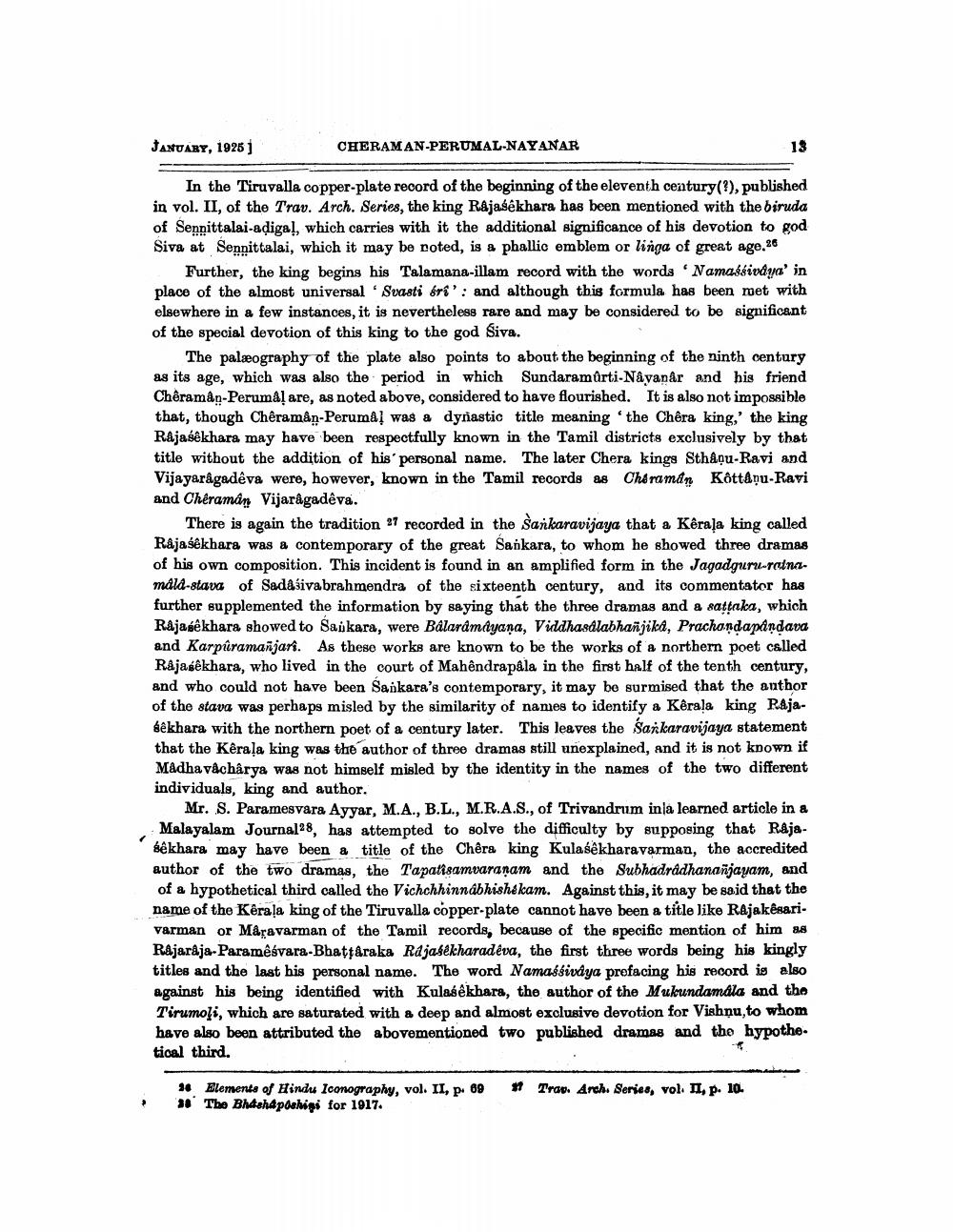________________
JANUARY, 1925)
CHERAMAN-PERUMAL-NAYANAR
13
In the Tiruvalla copper-plate record of the beginning of the eleventh century(?), published in vol. II, of the Trav. Arch. Series, the king R&jaśékhara has been mentioned with the biruda of Sennittalai-adigal, which carries with it the additional significance of his devotion to god Siva at Sennittalai, which it may be noted, is a phallic emblem or linga of great age 26
Further, the king begins his Talamana-illam record with the words Namaisivaya' in place of the almost universal Svasti sri': and although this formula has been wet with elsewhere in a few instances, it is nevertheless rare and may be considered to be significant of the special devotion of this king to the god Siva.
The palæography of the plate also points to about the beginning of the ninth century as its age, which was also the period in which Sundaramurti-Nayanar and his friend Chêramân-Perumal are, as noted above, considered to have flourished. It is also not impossible that, though Chêramån-Perumal was a dynastic title meaning the Chêra king,' the king Rajasekhara may have been respectfully known in the Tamil districts exclusively by that title without the addition of his personal name. The later Chera kings Sthâqu-Ravi and Vijayarågadeva were, however, known in the Tamil records as Charaman Kottanu-Ravi and Chéramán Vijarågadêva.
There is again the tradition 37 recorded in the Sankaravijaya that a Kéraļa king called Rajasekhara was a contemporary of the great Sankara, to whom he showed three dramas of his own composition. This incident is found in an amplified form in the Jagadguru-rainamála-stava of Sadasivabrahmendra of the sixteenth century, and its commentator has further supplemented the information by saying that the three dramas and a sattaka, which Rajasekhara showed to Saúkara, were Balaramdyana, Viddhasdlabhanjika, Prachandapandava and Karparamanjari. As these works are known to be the works of a northern poet called Rajasekhara, who lived in the court of Mahendrapala in the first half of the tenth century, and who could not have been Sankara's contemporary, it may be surmised that the anthor of the stava was perhaps misled by the similarity of names to identify a Kerala king Rajasekhara with the northern poet of a century later. This leaves the Sarkaravijaya statement that the Kerala king was the author of three dramas still unexplained, and it is not known if Madhaváchârya was not himself misled by the identity in the names of the two different individuals, king and author.
Mr. S. Paramesvara Ayyar, M.A., B.L., M.R.A.S., of Trivandrum inla learned article in a Malayalam Journal28, has attempted to solve the difficulty by supposing that Rajasekhara may have been a title of the Chêra king Kulasekharavarman, the accredited author of the two dramas, the Tapatisamvaranam and the Subhadradhananjayam, and of a hypothetical third called the Vichchhinnábhishekam. Against this, it may be said that the name of the Kéraļa king of the Tiruvalla copper-plate cannot have been a title like Rajakesarivarman or Maravarman of the Tamil records, because of the specific mention of him 9.8 RAjarája-Paramêsvara-Bhattaraka Rajasekharadeva, the first three words being his kingly titles and the last his personal name. The word Namassivdya prefacing his record is also against his being identified with Kulasekhara, the author of the Mukundamála and the Tirumoli, which are saturated with a deep and almost exclusive devotion for Vishnu, to whom have also been attributed the abovementioned two published dramas and the hypothe. tical third.
26 Elements of Hindu Iconography, vol. II, p. 69 30 The Bhashapdalini for 1917.
51
TrapArch. Series, vol. II, p. 10.




